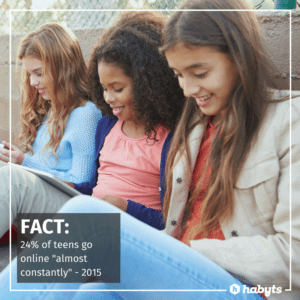Did you know you spend 3 times longer on websites and apps that make you unhappy than you do on apps that make you happy? Why? And how can you teach your kids not to do the same?
What’s currently happening…
A Ted Talk from Adam Alter revealed that the average digital media user will spend just nine minutes a day on apps that make them happy and feel good about themselves. In comparison, they spend an average of 27 minutes a day on websites and apps that make them feel bad about themselves.
What were these apps? Take a guess between 1 and 2.
- Social Networking, Gaming, Entertainment, Dating, News, Web Browsing
- Relaxation, Exercise, Weather, Reading, Education, Health
You guessed it. Row 1 (with social media, gaming and entertainment) are the unhappy websites and apps we spend 3 times longer on than row 2 — the happy apps.
We can understand why social media and the news might make us more unhappy, but you might not have guessed that gaming, entertainment and just general web browsing can make you feel the same.
RELATED: Want to block the apps making your kids miserable?
Stop social media for a block of time to boost your kids’ happiness!The problem is, it’s rubbing off on our kids too.
Many of us grew out of the self-conscious phase without having to have a documented online history of it. Kids these days aren’t so fortunate.
They believe their online presence in places like Facebook, Instagram or even in their online game (whatever that may be) is essential to their popularity. If other kids are hanging out in these digital spots but they aren’t then they’re going to be judged. Mocked. Bullied.
While there are plenty of positive things about social media (connection) and gaming (improved hand-eye coordination), the online world has a dark side. It can be a little opinionated, and it can be a little hurtful. From not getting enough likes on a picture to “trolls” that hound your child while they’re playing their online game.
It’s hard enough figuring out who you are as a kid without having to have the online persona to match.

We hear you, Helen! But why aren’t we stopping ourselves?
We know kids are still developing their impulse control, so we can forgive them for thinking that the world begins and ends inside a screen. But shouldn’t we be setting a better example?
- Well, good news — it’s not our fault.
- Bad news — companies have figured out our weak spot, and we’re falling for it every time.
The reason we’re not stopping ourselves from consuming this mindless digital content (all the stuff that makes us feel bad about ourselves) is that there are no stopping cues anymore.
What are stopping cues? I hear you ask. Good question.
Stopping cues are physical reminders that you can get up and do another activity. For example, you get to the end of a chapter in a book — you can decide whether to continue or do something else. Your TV programme ends and you have to wait until next week to watch the next episode.
“Binge watching” on apps like Netflix and endless scrolling content that we find across all digital platforms today has robbed us of stopping cues. In fact, media companies are actually hiring psychologists and experts to replace stopping cues with ‘hooks’ that make us want to continue to stay on their media.
What does this mean for our kids?
Well, if there are no stopping cues and kids are still developing the part of the brain that controls impulses — we’ve got a problem. A big problem.

Kids these days no longer understand delayed gratification. They can’t sit at a restaurant or stand in line without being constantly entertained. That’s because they have access to constant stimulation online, which leads them to believe they need to be entertained AT ALL TIMES.
It’s a parent’s worst nightmare.
Luckily, there is a solution.
3 steps to making your child happier
1) Create your own stopping cues
As the marshmallow experiment taught us, most of us are really bad at resisting temptation (though we fair a little better if we understand delayed gratification).
However, if we create our own stopping cues we can avoid temptation altogether. This makes it easier to teach your kids delayed gratification in the long run too.
So, we’ve brainstormed a few ideas for you to get started:
- No phones at the dinner table.
- No screens in the bedroom.
- No devices when you have a friend around.
- No TV after 7pm.
- No more than 2 hours screen time tops.
2) Let your kids be bored
We know, you must think we’ve gone mad. But 1 in 5 parents agree with us — boredom helps your kids creativity. Encouraging unstructured play where their imaginations can run wild with them is the best thing you can do to show them that there is life outside of their devices.
Yes, it might be hard at first and you might have to give them a few auto-cues to get started; make up a dance routine, write me a short story, come up with a meal you want to cook for family dinner night…etc. But in the long-run, you’ll have a more well-rounded, balanced child that can find ways of entertaining themselves quite happily.
3) Be brave, ‘Mom Up’
Or ‘Dad Up’…because this is going to require a team effort. We’re not saying this is going to be easy. But when kids can’t do something for themselves, they need their parents to step in and help them out. We’ve got to show them that spending hours online is making them miserable…they just don’t know it yet.
You’re allowed to be tough. In fact, there are rules kids want when it comes to technology that most of us don’t even know about yet. And kids know — though they’ll never admit it — FOMO (fear of missing out) is easier to overcome if your parents have rules in place when it comes to technology. They like routine and structure. They like to know you’re keeping them safe. It will just take another 10+ years before they acknowledge it…
If you need a bit of motivation to get started, here’s what one brave Mom has to say on the matter.
Have you noticed a difference in your kid’s attitudes? Get in touch via the comment section below!